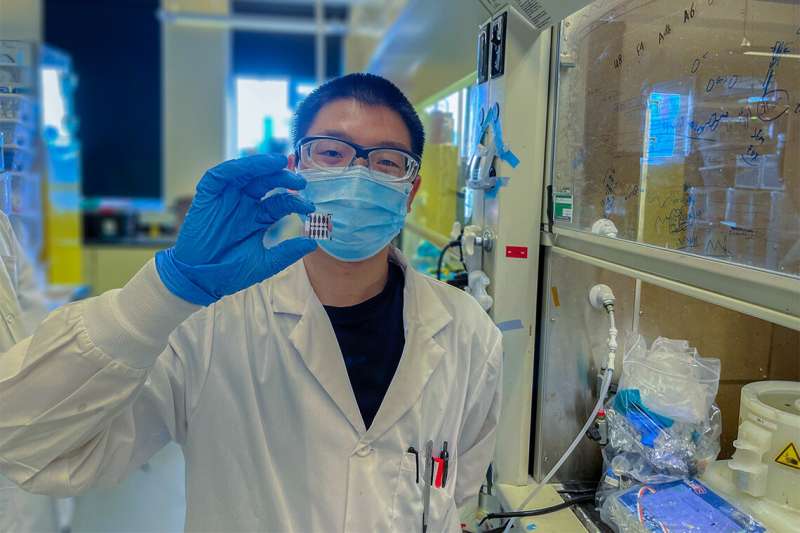Quantum innovation advances low-cost alternative solar technology
4 min read
A staff of scientists from the College of Toronto’s School of Utilized Science & Engineering has leveraged quantum mechanics to enhance the energetic layer inside of a product identified as an inverted perovskite photo voltaic cell—a technologies that could one particular working day outcome in mass-market place photo voltaic cells that price tag a fraction of these currently on the market place.
At present, virtually all commercial solar cells are designed from superior-purity silicon, which takes considerable strength to develop. But researchers all over the environment are experimenting with alternative solar technologies that could be produced and installed with much less electrical power and at decrease expense.
One particular of these choices, which is staying studied in the Sargent Group lab, is identified as perovskite. The electrical power of perovskite materials comes from their unique crystal structure, which permits them to absorb light in a extremely skinny layer and change it into electricity competently.
“Perovskite crystals are designed from a liquid ink and coated on to surfaces making use of technologies that is by now nicely-set up in sector this sort of as roll-to-roll printing,” claims Hao Chen, a article-doctoral researcher in Sargent’s lab and just one of 4 co-lead authors of a new paper released in Nature Photonics.
“For the reason that of this, perovskite solar cells have the likely to be mass produced at considerably lessen power price than silicon. The challenge is that right now perovskite solar cells lag standard silicon cells in balance. In this analyze, we aimed to close that hole.”
Chen, together with his co-guide authors—Ph.D. applicant Sam Teale and submit-doctoral scientists Bin Chen and Yi Hou—are employing a strategy centered on an inverted photo voltaic mobile composition.
In most prototype perovskite photo voltaic cells, electrons exit by a negative electrode at the bottom layer of the mobile, with the “holes” they leave behind exiting by way of a constructive electrode at the best.
Reversing this arrangement enables the use of alternate production tactics and previous exploration has demonstrated that these can boost the balance of the perovskite layer. But the transform arrives at a price tag in phrases of effectiveness.
“It is really tricky to get very good get in touch with in between the perovskite layer and the leading electrode,” states Chen. “To resolve this, researchers typically insert a passivation layer built of natural and organic molecules. That will work definitely properly in the standard orientation, mainly because ‘holes’ can go correct by means of this passivation layer. But electrons are blocked by this layer, so when you invert the mobile it gets to be a massive issue.”
The workforce overcame this limitation by having benefit of quantum mechanics—the physical basic principle that states the conduct of supplies at incredibly smaller length scales is distinct from what is noticed at larger sized types.
“In our prototype photo voltaic cells, the perovskites are confined to an very slender layer—only one particular to a few crystals in height,” suggests Teale. “This two-dimensional condition allows us to access attributes connected with quantum mechanics. We can manage, for illustration, what wavelengths of mild the perovskites take in, or how electrons move in the layer.”
The group initial applied a chemical strategy recognized by other groups to produce a two-dimensional perovskite floor atop their solar cell. This enabled the perovskite layer to attain passivation on its have, doing away with the will need for the organic and natural layer completely.
To prevail over the electron blocking effect, the crew greater the thickness of the perovskite layer from 1 crystal in top to three. Personal computer simulations had revealed that this modify would change the electrical power landscape sufficiently to enable electrons to escape into an exterior circuit, a prediction that was borne out in the lab.
The energy conversion performance of the team’s cells was calculated at 23.9 %, a stage that did not fade immediately after 1,000 several hours of procedure at space temperature. Even when subjected to an field-normal accelerated growing older method at temperatures up to 65 C, the functionality only diminished by 8 % immediately after more than 500 hours of use.
Future operate will focus on additional growing the steadiness of the cells, which includes under even bigger temperatures. The crew would also like to make cells with a larger area location, as the recent cells are only about five square millimeters in size.
Continue to, the latest benefits bode nicely for the long run of this substitute solar technological innovation.
“In our paper, we examine our prototypes to the two traditional and inverted perovskite photo voltaic cells that have been a short while ago released in the scientific literature,” claims Teale.
“The mix of substantial security and significant effectiveness we attained genuinely stands out. We ought to also maintain in thoughts that perovskite technological know-how is only a pair of a long time previous, whilst silicon has been labored on for 70 several years. There are a whole lot of advancements however to appear.”
Hao Chen et al, Quantum-measurement-tuned heterostructures help effective and steady inverted perovskite solar cells, Nature Photonics (2022). DOI: 10.1038/s41566-022-00985-1
Quotation:
Quantum innovation advancements small-expense option photo voltaic technological know-how (2022, April 8)
retrieved 17 April 2022
from https://phys.org/news/2022-04-quantum-innovations-small-expense-different-solar.html
This document is topic to copyright. Apart from any honest dealing for the intent of non-public research or study, no
aspect may perhaps be reproduced without the need of the published permission. The written content is provided for information and facts reasons only.







